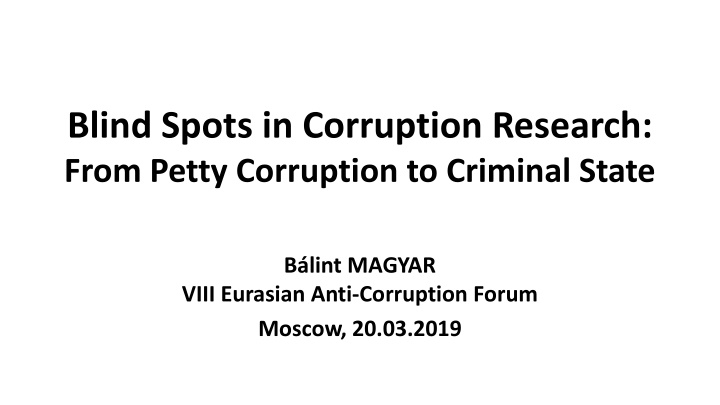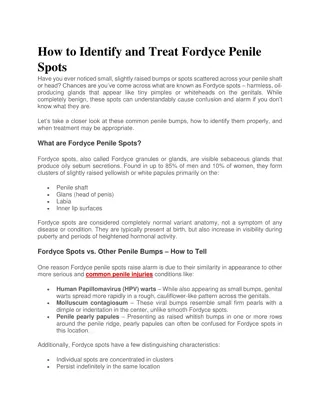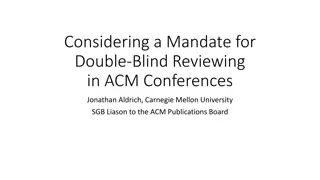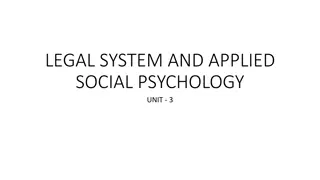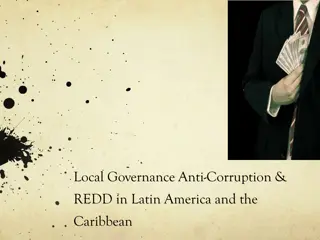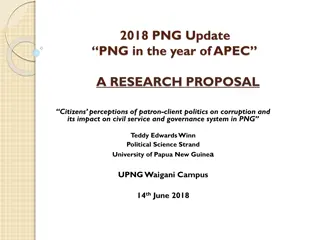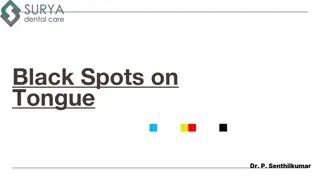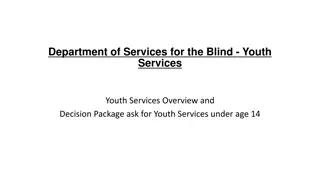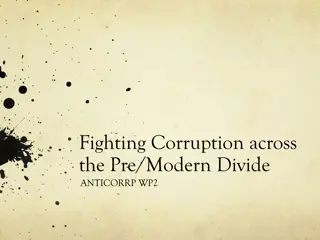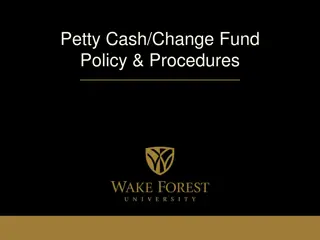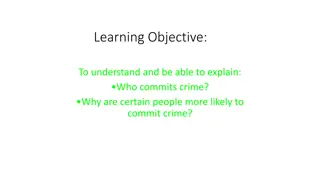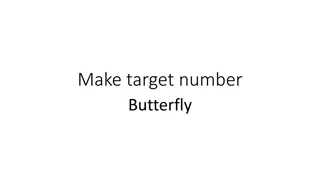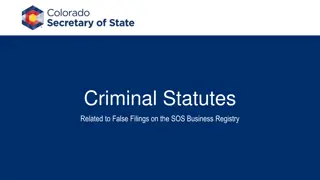Blind Spots in Corruption Research: From Petty Corruption to Criminal State
Explore blind spots in corruption research, assumptions of Transparency International's corruption indicators, and main features of different levels of corruption. Understand what the Corruption Perceptions Index measures and what it overlooks.
Download Presentation

Please find below an Image/Link to download the presentation.
The content on the website is provided AS IS for your information and personal use only. It may not be sold, licensed, or shared on other websites without obtaining consent from the author.If you encounter any issues during the download, it is possible that the publisher has removed the file from their server.
You are allowed to download the files provided on this website for personal or commercial use, subject to the condition that they are used lawfully. All files are the property of their respective owners.
The content on the website is provided AS IS for your information and personal use only. It may not be sold, licensed, or shared on other websites without obtaining consent from the author.
E N D
Presentation Transcript
Blind Spots in Corruption Research: From Petty Corruption to Criminal State B lint MAGYAR VIII Eurasian Anti-Corruption Forum Moscow, 20.03.2019
Assumptions of TIs corruption indicators Corruption Perceptions Index (CPI) o a composite index published annually by Transparency International (TI) o broad definition of corruption ( the abuse of entrusted power for private gain ) o three groups of phenomena: o general instances of corruption ( diversion of public funds, prevalence of officials using public office for private gain etc.); o specific instances of corruption ( bribery, state capture by narrow vested interests etc.); o institutional guarantees ( ability of governments to contain corruption, adequate laws on financial disclosure, legal protection for whistleblowers [and] journalists etc.). The main assumption: understanding corruption as a deviance o understanding the state by its formal identity: as dominantly an institution of the public good, with some subordinates who deviate from that purpose; o the state does want to persecute corruption, just it may not have the ability to do so. The blind spot: when the initiator of a corrupt transaction is neither the company nor public administrators with the potential to extort, but the state itself. An example: o CPI surveys private actors whether they have to bribe officials to get things done, for example to win a public procurement tender... o ...but this way the survey disregards the situation when the entrepreneur does not even have the chance to bribe anyone, for public procurements are already distributed from the top.
What does CPI measureand what does it not? T T T C F C F C F Bribery: perceived measured Embezzlement: perceived not measured Criminal state: not perceived not measured Legend: T: truster (principal); F: fiduciary (agent); C: corrupter
Main Features of the Four Levels of Corruption Character of relationship between the actors Regularity and scope of corrupt transactions Direction of corrupt action Distribution of corrupt transactions Form of corrupt networks Economic nature of corruption Medium of corrupt exchange Nature of corruption Spread of corruption Petty corruption Free market corruption Non- systemic or systemic Non- centralized Ad hoc and partial Kickback money Bottom-up n.a. Competitive Voluntary Bottom- up state capture Non- systemic or systemic Oligopolistic / locally monopolistic Temporary / permanent and partial Moderately centralized Parallel verticals Voluntary / Coercive Kickback money Bottom-up Permanent and partial (vassal chains) Top-down state capture Non- systemic or systemic Oligopolistic / locally monopolistic Partially centralized Parallel verticals Protection money Top-down Coercive Permanent and general (vassal chains) Criminal state Single vertical Protection money Top-down Centralized Systemic Monopolistic Coercive Grand corruption
Different states attitude toward corruption Intention of the dominant institution (form) Discretional treatment resulting from corruption meets the intention of Political regime (state type) Dominant forms of collusive corruption Regulator s intention liberal democracy (constitutional state) neither the regulator, nor the dominant institution (non- structural deviation) free market corruption (sporadic) normative (formal state laws) State normative neither the regulator, nor the dominant institution (non- structural deviation) Corrupt state free market corruption (endemic) normative (formal state laws) normative bottom-up state capture top-down state capture the regulator, but not the dominant institution (structural deviation) Captured state normative (formal state laws) discretional both the regulator and the dominant institution (norm / constitutive element) Criminal state patronal autocracy (mafia state) discretional (informal patronal decisions) criminal state discretional
Types and some features of reiderstvo in post-communist regimes Strength of the state Legiti- macy of raiding The initiator or client of the corporate raiding Organized upperworld: chief patron (top level public authority) Low or middle level public authority Rival entrepreneurs or oligarchs Organized underworld: criminal groups XXXXXXXXXXXXXXXXX XXXXXXXXXXXXXXXXX XXXXXXXXXXXXXXXXX Strong state White raiding XXXXXXXXXXXXXXXXX XXXXXXXXXXXXXXXXX XXXXXXXXXXXXXXXXX XXXXXXXXXXXXXXXXX XXXXXXXXXXXXXXXXX XXXXXXXXXXXXXXXXX Gray raiding XXXXXXXXXXXXXXX XXXXXXXXXXXXXXXXX XXXXXXXXXXXXXXX XXXXXXXXXXXXXXX XXXXXXXXXXXXXXX Crime Black raiding Weak state Criminal state Single-pyramid patronal system Monopolized Market + state + oligarch capture State crime Corporate crime Multi-pyramid patronal system Institutional environment and features of the raiding action Oligarchic Competitive n.a. Market + state capture
Patterns of corruption and the states response in three ideal-type political regimes Liberal democracy Post-communist patronal autocracy Communist regime surplus corruption sellers corruption competitive market corruption n.a. n.a. relational market corruption shortage corruption buyers corruption administrative market corruption system destroying corruption system constituting corruption system lubricating corruption generally/normatively sanctioned selectively preferred ( , roof ) or sanctioned moderately tolerated impartial jurisdiction evidence crime committed, process launched automatically politically selective jurisdiction kompromat crime committed, process launched on the basis of political decision show trials fabricated accusation crime not committed, process launched on the basis of political decision
Patronage Politics: State Functions Subordinated to Private Interests The basis for the term used patronage in post-communist regimes Alternative terms used for the description of 1. Actor network / patronal / clan state patrimonial / neopatrimonial state rent-seeking / kleptocratic / predatory state corrupt / captured / criminal state 2. Action (targeting power) Action (targeting goods) Legality 3. 4.
Patronage Politics: State Functions Subordinated to Private Interests: the Post-Communist Mafia State The basis for the term used Alternative terms used for the description of patronage in post- communist regimes 1. Actor clan state 2. Action (targeting power) 3. Action (targeting goods) 4. Legality neopatrimonial state Post-Communist Mafia State predatory state criminal state
Primary characteristics of state and private property relations in three ideal-type political regimes Post-communist patronal autocracy The political group in power controls and partially appropriates private property and coordination of the market Power&ownership ( & ) is the determinative form of ownership Relational coordination is the determinative coordinating mechanism, overseen and directed by the adopted political family (relational market) Liberal democracies Communist regime The political group in power ensures the dominance of private property and market coordination The political group in power, the communist party emposes dominance of state property and bureaucratic coordination Private property is the dominant form of property State property is the dominant form of property Market coordination is the dominant mechanism of coordination Bureaucratic coordination is the dominant coordinating mechanism (competitive market) (administrative market)
Thank you for your attention. magyarbalint52@gmail.com
